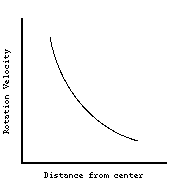
Answer any 7 of the following 8 questions. All relevant equations have been given on the cover page (not visible in WWW version). Each is worth 14 points.
1) Two face-on binary systems, Alpha and Beta, have companion stars with identical orbital periods. The two systems also have the same angular size as seen from Earth. Parallax measurements show that system Alpha is further away. Based on this information, which system has the more massive central star, Alpha or Beta? Justify your answer fully.
2) About 90% of the visible matter in our galay is Hydrogen gas. Most of this is at very low temperatures. We can detect it by looking for a spectral emission line with a wavelength of 21-cm. This same line is not visible in stars, even though stars are composed largely of Hydrogen, because it is a "forbidden line", not seen in high density gas like that found in the atmosphere of a star.
3) Suppose two stars, Gamma and Delta, are observed to have the same apparent luminosity and same red color. Observations of the spectral line widths of the two stars show that they have the same size (radius). We also know that there is a substantial amount of interstellar gas and dust (ISM) along the line of sight to star Delta but very little along the line of sight to Gamma.
4) Over the course of the main sequence lifetime of the Sun, its absolute luminosity has gradually grown due to changes within the core.
5) Cepheid variables undergo periods of expansion and contraction. These changes can be understood through the mechanism of hydrostatic equilibrium (HSE).
6) Black holes in binary systems are often thought to exist based on the effects they have on their companions or their surroundings.
7) Suppose our galaxy had no dark matter. What would the rotation curve for the disk of the galaxy look like? Draw in what you think it would look like on the graph below. The Keplerian curve (which we see in our solar system) is included for reference. If the galaxyıs rotation curve would exactly match this, just write "no change" on the graph below. After drawing in your curve, explain why you drew it the way you did (or wrote "no change").

8) One possible component of the dark matter in our galaxy are planet-sized masses known as MACHO's. Until recently, observation of these objects has been impossible.